Concrete pavers are set in bedding sand, which is placed over a base material that can consist of untreated aggregate base, bituminous or cement treated base, or even Portland cement concrete. The spaces between the individual paving units is filled with clean high quality joint sand. Any disharmony between any of these could lead paver defects. Let us understand a bit deeper about type paver defects and how to identify and measure them in term of severity.
1. Damaged Pavers
Description: Damaged pavers describe the condition of the paver blocks. Block damage would include paver distresses such as a chip, crack, or spall. Block damage would be indicative of load-related damage such as inadequate support causing shear breakage, etc.
Identification: Damaged pavers would include paver distresses such as a chip, crack, or spall. Cracked pavers with little to no opening will not affect performance.
How to Measure: Damaged pavers are measured in square meters of surface area. Random individual cracked pavers are not counted. The severity is evaluated by the degree of distress.
Severity Levels:
Severity Level | Item |
Low | Individual cracks, spalls, or weathering |
Medium | Advanced cracking, spalling, or weathering |
High | Blocks are in multiple pieces or are disintegrated |
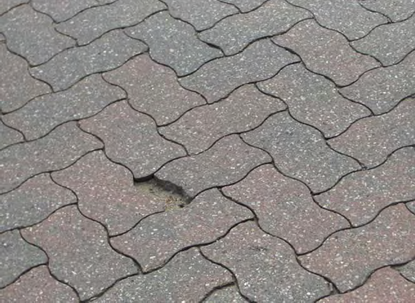
Low Severity Damaged Pavers
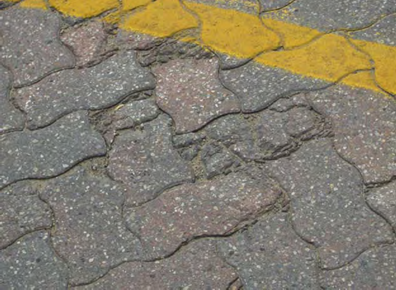
Medium Severity Damaged Pavers
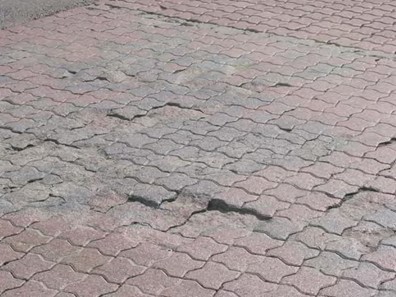
High Severity Damaged Pavers
2. Depressions
Description: Depressions are areas of the pavement surface that have elevations that are lower than the surrounding areas. Depressions are caused by settlement of the underlying subgrade or granular base. Settlement is common over utility cuts and adjacent to road hardware. Depressions can cause roughness in the pavement, and when filled with water, can cause hydroplaning of vehicles.
Identification: Visual examination is not always a reliable technique for detection of depressions, especially for low severity depressions. The most reliably method to identify depressions is to utilize a 3 m straight edge. Changes in shades of color on a pavement surface can give the impression of differential elevation where none exists. The apparent depth of differential elevation is often exaggerated by shadows in the early morning and late afternoon, as well as the chamfer on the paver edges. Standing water and stains can be used to visually identify depressions, however, the boundaries and depth should be established using the straight edge. Be careful to distinguish heaves from depressions.
How to Measure: Depressions are measured in square metres of surface area. The maximum depth of depression defines the severity. Depressions larger than 3 m across should be measured with a stringline.
Severity Levels:
Severity Level | Maximum Depth of Defect |
Low | 5 – 15 mm [0.2 to 0.6 inches] |
Medium | 15 – 30 mm [0.6 to 1.2 inches] |
High | > 30 mm [1.2 inches] |
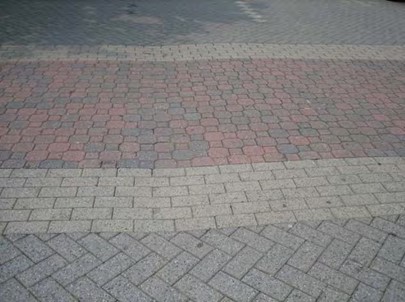
Low Severity Depression
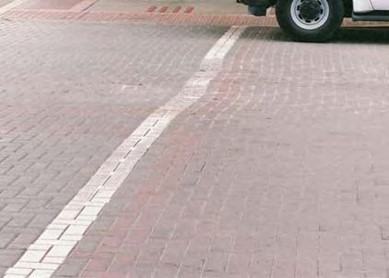
Medium Severity Depression
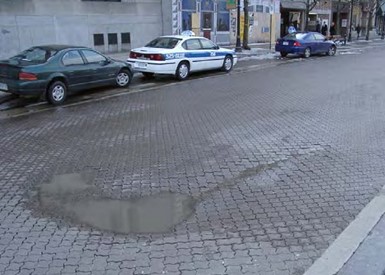
High Severity Depression
3. Edge Restraint
Description: Edge strips and curbing are forms of restraints that provide lateral support for paver pavements. Lateral restraint is considered essential to resist lateral movement, minimize loss of joint and bedding sand, and prevent block rotation. Edge strips/curbs can comprise prefabricated angle supports, concrete curbs, etc. This distress is accelerated by traffic loading.
Identification: Loss of lateral restraint is characterized by widening of the paver joints at the outer pavement edge or at the transition of pavement types. Locally pavers at the pavement edge can exhibit both vertical and horizontal rotation as well as local edge settlement. The distress is most notable within 0.3 to 0.6 m (1 ft to 2 ft) of the pavement edge.
How to Measure: Loss of edge restraint is measured in linear metres [linear feet] of pavement edge (measure the movement of the edge restraint).
Severity Levels:
Severity Level | |
Low | Evidence of increased joint width, (6 – 10 mm) [0.25 to 0.4 inches] to no evidence of paver/curb rotation |
Medium | Increased joint width (11 – 15 mm) [0.4 to 0.6 inches], with evidence of paver/curb rotation |
High | Increased joint width (> 15 mm) [0.6 inches], with noticeable of paver/curb rotation and local settlement |
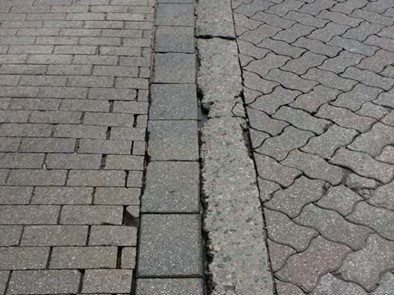
Low Severity Loss of Edge Restraint
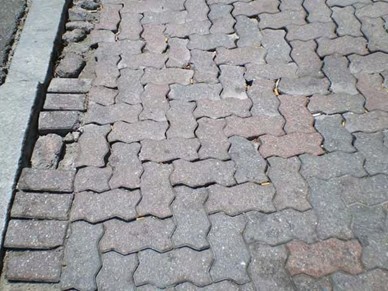
Medium Severity Loss of Edge Restraint
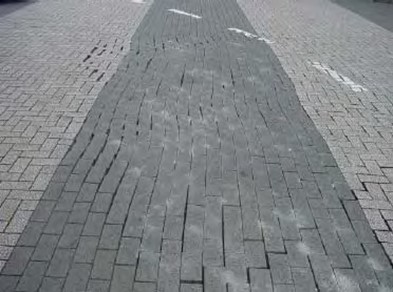
High Severity Loss of Edge Restraint
4. Excessive Joint Width
Description: Excessive joint width is a surface distress feature in which the joints between blocks have widened. Excessive joint width can occur from a number of factors including; poor initial construction, lack of joint sand, poor edge restraint, adjacent settlement/heave, etc. As joints get wider, the block layer becomes less stiff and can lead to overstressing the substructure layers.
Identification: Optimal block spacing is typically specified as 1.5 to 3 mm [0.05 to 0.12 inches]. As joints get wider, the individual blocks may show signs of rotation.
How to Measure: Excessive joint width is measured in square metres (square feet) of surface area. The average joint widening defines the severity. As concrete pavers are manufactured with a beveled edge, care must be taken to ensure the actual joint width is measured.
Severity Levels:
Severity Level | Average Joint Width |
Low | 6 – 10 mm [0.25 to 0.4 inches] |
Medium | 11 – 15 mm [0.4 to 0.6 inches] |
High | > 15 mm [0.6 inches] |
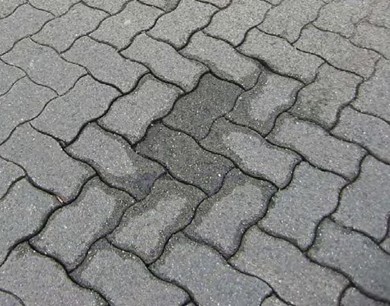
Low Severity Excessive Joint Width
(< 5 mm [0.25 inches] wide with or without joint sand loss and performing well)
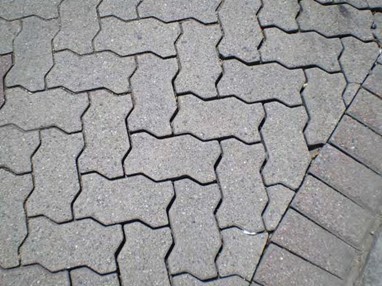
Medium Severity Excessive Joint Width
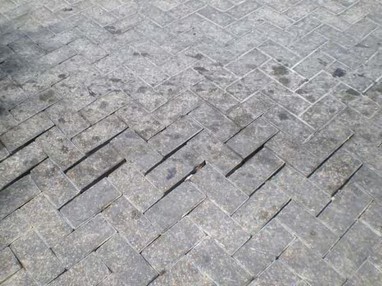
High Severity Excessive Joint Width
(greater than 5 mm [0.2 inches] with loss of joint sand and misalignment)
5. Faulting
Description: Faulting are areas of the pavement surface where the elevation of adjacent blocks differ or have rotated. Faulting can be caused by surficial settlement of the bedding sand, poor installation, pumping of the joint or bedding sand. Local roughness can reduce the ride quality. Faulting can pose a safety hazard for pedestrians. Faulting can be corrected by resetting the blocks.
Identification: Faulting is characterized by small areas of individual blocks standing proud of each. This distress is often associated with more severe distresses such as settlement, heave, rutting, etc.
How to Measure: Faulting is measured in square metres (square feet) of surface area. The maximum elevation difference defines the severity.
Severity Levels:
Severity Level | Elevation Difference |
Low | 4 – 6 mm [0.15 to 0.25 inches] |
Medium | 6 – 10 mm [0.25 to 0.4 inches] |
High | > 10 mm [0.4 inches] |
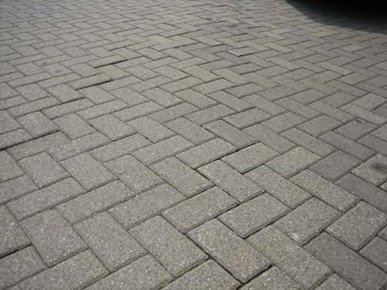
Low Severity Faulting
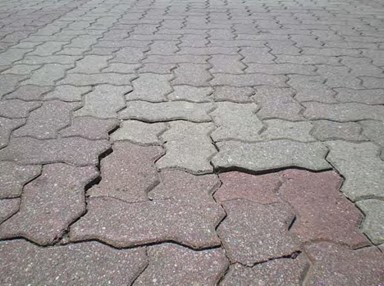
Medium Severity Faulting
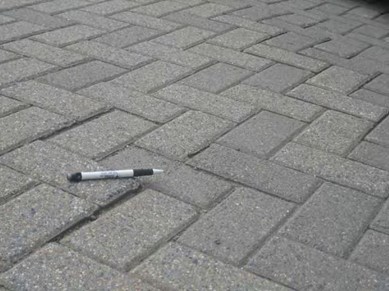
High Severity Faulting
Summary
This is the first part of the article on paver defects type and identifications. Click here for part 2 of this article.










